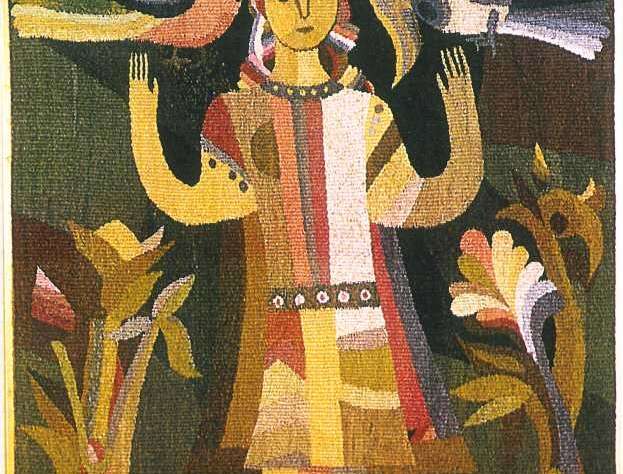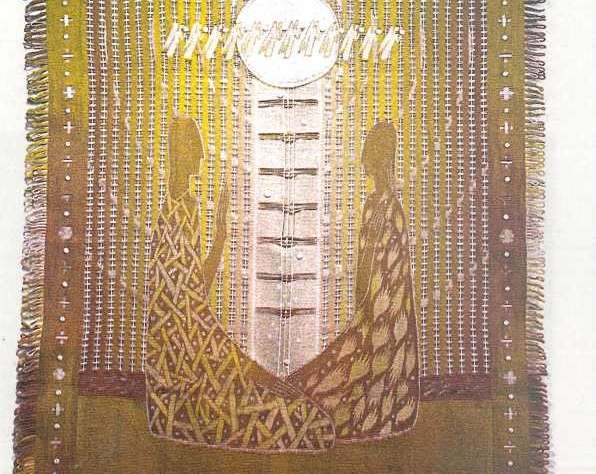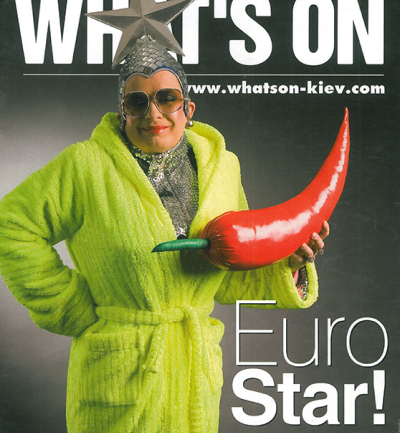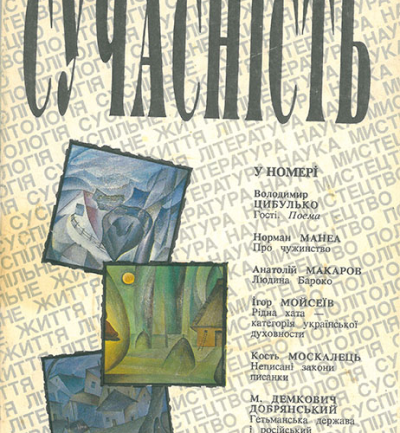NATALKA AND LIDIA BORYSENKO: AN INVITATION TO PARADISE
Olena Zahaietska
Art Critic
In contemporary decorative art, among the works of many prominent masters, the creativity of two sisters — Natalka and Lidia Borysenko — draws attention with its freshness and originality of artistic approach. They are among the founders and regular participants of the All-Ukrainian Triennials of Artistic Textile, including the most recent presentation — the III All-Ukrainian Triennial of Artistic Textile, held from late 2010 to early 2011, as well as other Ukrainian and international exhibitions and solo shows. Against the backdrop of diverse thematic, material, and technical approaches in decorative art, their works stand out for their restrained delicacy, softness, sophistication, conciseness, multilayered meanings, depth and originality of concept, and a positive attitude towards the surrounding world and all those living nearby. After all, just as in the times of the biblical Noah, we all share one planet, one fragile boat — the “Ark” imagined by Natalka Borysenko — sailing across the ocean of the Universe. (It is worth noting that this work won the second prize at the First All-Ukrainian Triennial of Artistic Textile.)
Natalka and Lidia share many things in common. Both were born in Lviv (with a ten-year age difference), grew up in an intellectual family of the renowned sculptor Valentin Borysenko, graduated from the then Lviv Institute of Applied and Decorative Arts, and later became members of the National Union of Artists of Ukraine. Both are engaged in teaching activities and have worked together at the Art Studio of the National Union of Artists of Ukraine, where Lidia continues to work today, while Natalka established her own studio.
The creative atmosphere surrounding Natalka and Lidia encouraged the fullest expression of their artistic ideas. They mastered the technical and technological means of artistic textile deeply. Their body of work includes numerous tapestries, batiks, and embroideries; in many pieces, especially those of a collage nature, various textile art techniques are combined, lending the works originality and a special charm.
It is worth noting that the thematic horizons of the sisters’ creativity are quite close: they are concerned with issues of modern civilization, the passage of time, harmonious coexistence between humans and nature, and between humans and the cosmos. They also draw upon ancient Ukrainian artistic traditions and biblical themes, revealing a wide spectrum of sincere human relationships. Therefore, many of their works, created in various techniques, often bear titles such as “Meeting,” “Two,” “Two Sisters,” and others. A distinctive feature of these works is their symbolism, metaphorical nature, and associative quality.

LIDIA BORYSENKO Mind and Heart, 1998
Tapestry, wool, cord, silk, author’s technique
Both Natalka and Lidia interpret the traditional and multi-layered theme of the tree in their own unique ways. These are stylized real trees as well as unusual, paradisiacal ones that exist only in the imagination of the artists, symbolizing their dreams and desires. Essentially, this is a nostalgia for those fairy-tale times when paradise existed on Earth, and peace and grace reigned both in nature and in human souls.
Lidia invites the viewer into the shade of the paradisiacal trees, which embody ideas of beauty, harmony, and goodness (graphic series “Paradise Trees”). Natalka named her diptych composition “Invitation to Paradise.” The exquisite embroidered panel, exhibited at the III All-Ukrainian Textile Art Triennial, conveys the artist’s delicate and reverent attitude toward the fantastically beautiful life of paradise through its refined and gentle tones. This blissful world is one we, too, would like to immerse ourselves in, forgetting daily worries, problems, and hardships.
The artist’s mission is seen as one of catharsis, cleansing the soul, and fostering a readiness to do good for others. Contemporary realities compel us to reassess life’s values through an ethical lens. Morality becomes an essential component for both local and global endeavors. We repeatedly witness that aggression and violence—not only invading real life but also weighing heavily as emotional and informational burdens in many modern art projects—ultimately lead to confrontation, resistance, and natural cataclysms. Art, as a language understood by every soul open to it, should ennoble that soul and cultivate a love for beauty. The phrase “Beauty will save the world,” often repeated without much thought, remains profoundly relevant and will continue to be so for a long time.

NATALKA BORYSENKO, Among the Branches, 2006
Cotton, embroidery
Contemporary decorative art is actively expanding both its thematic and expressive possibilities, making use of traditional techniques as well as elements from other forms of visual art—painting, graphics, sculpture, performance, and more. The Borysenko sisters are among those who employ a wide range of means to fully realize their artistic visions.
Natalka Borysenko primarily works in textile art, where the foundation is the thread. She adores the thread, considering it an embodiment of life’s essential values. “Thread is that connection, that ray of light that ties me to heaven and earth, and I am like a small knot between the above and the below, between birth and infinity…” the artist explains. And she works with textile masterfully—brilliantly, in fact. This is evident in her tapestries, embroideries, and fabric paintings (Ark, The Road, The Road of Life, Two, Mother and Child, Meeting, Dialogue, The Kiss, The Bow, Creation of the World, Ornaments, Day and Night, among others). She also incorporates collage and combines various techniques, as seen in several of her works presented at the latest Triennial of Textile Art (Frost, The Birds Have Arrived, Composition with Feathers).

LIDIA BORYSENKO, Time, 2008
Wood, oil
Lidia Borysenko continually expands the range of techniques in which she works. These include tapestry (The Last Hero, Two Sisters, Reason and Heart), batik (the Christmas series), embroidery (Meeting, Return to the Thread, Journey, Touch), painting (The Letter, Gentle World), tempera on gesso (Time, Meeting the Sun), graphic series (Circles, Tree Letters), and pysanky (about two thousand, some created on ostrich eggs). She also works with collage and has recently become interested in the art of vytynanka (traditional paper cutting). All these techniques serve her in bringing to life the many ideas that constantly well up from her restless creative soul.
Her original tapestry Reason and Heart (1998), designed to be viewed with backlighting, represented Ukraine at the international Textile Biennial in Łódź, Poland. Two symmetrically placed female figures engage in a quiet dialogue. In essence, the piece explores the theme of two sisters—a recurring motif in many of Lidia’s works, regardless of the medium. This motif reflects the deep spiritual connection between the sisters, who, despite their different temperaments, understand each other with half a word and half a glance.
Lidia has many recurring motifs that are especially close to her heart. Among them are a ball of thread, graceful hands, musical staves and notes, angels holding lanterns, and stylized human figures that she sometimes incorporates as elements of a kind of graphic mosaic (as seen in her Circles series). In the artwork Time, these nameless human silhouettes evoke grains of sand falling to the bottom of an hourglass. Some of Lidia’s works are densely filled, yet their clear structural composition allows the viewer to perceive both the overall image and its intricate details—each viewing revealing new layers of meaning.
At the most recent Triennial of Textile Art, Lidia presented an art performance titled The Magic Ball of Thread, in which eleven participants (symbolizing the year 2011) tossed a ball of white cord to one another, each sharing their thoughts about textile art. She also exhibited a piece of textile-based graphic art by the same name, The Magic Ball of Thread, in which the thread is represented by musical notes—an organic connection, as music has fascinated her since childhood.
Communication is one of the central themes in Lidia’s artistic practice. She wholeheartedly agrees with her favorite writer, Antoine de Saint-Exupéry, who wrote: “The only true luxury is the luxury of human connection.” And may that luxury accompany us always.

NATALKA BORYSENKO, Paganism of the Ancient Slavs. Central Part of the Triptych, 1997
Tapestry, wool, hand weaving



